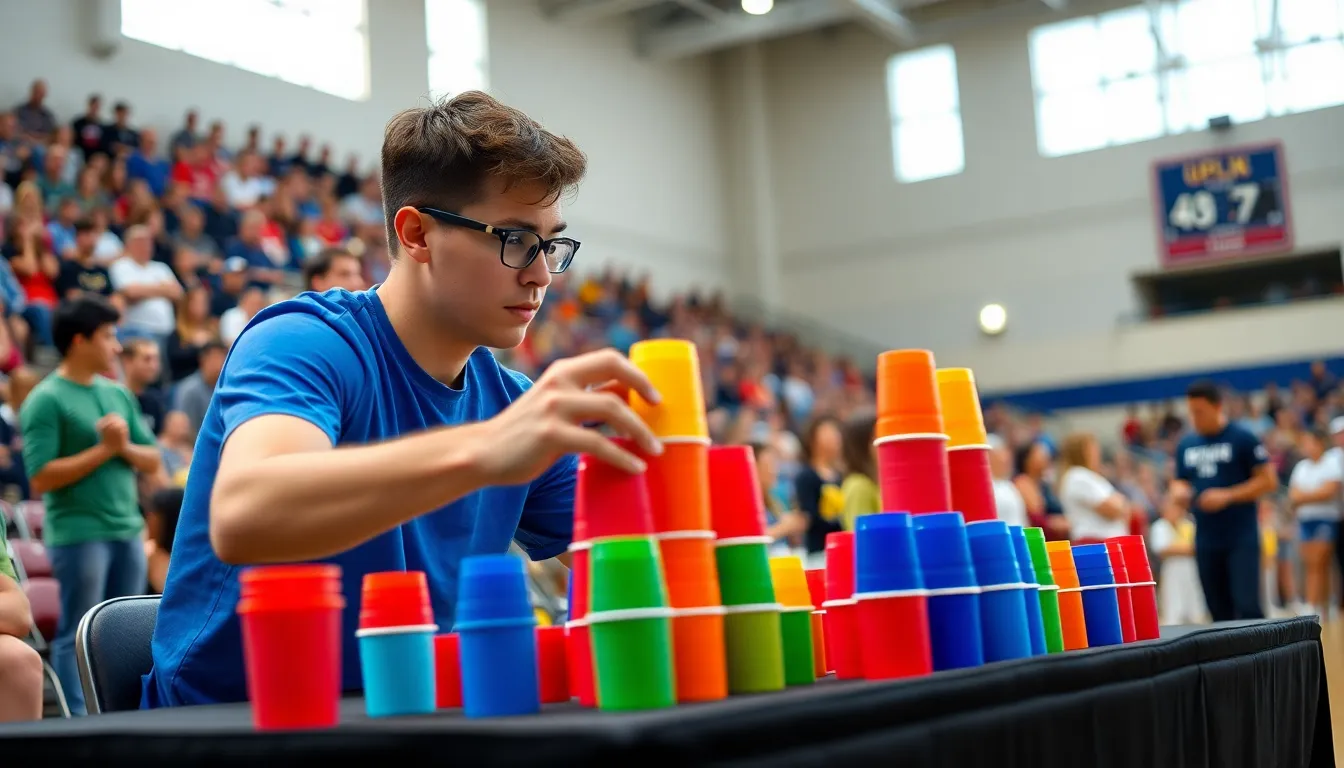In a world where multitasking is the name of the game, cup stacking takes the crown for the ultimate test of speed, coordination, and a dash of flair. Picture this: a mountain of plastic cups, a timer ticking down, and the thrill of racing against the clock. It’s not just a game; it’s a high-stakes showdown that’ll have you questioning your life choices as you fumble to stack those cups faster than a caffeinated squirrel.
Cup stacking isn’t just for kids—adults are getting in on the action too. Whether it’s a friendly competition at a family gathering or a serious showdown at a local tournament, this quirky sport offers fun and excitement for everyone. So grab your cups, channel your inner champion, and get ready to stack your way to glory. Who knew that a simple game could turn into a hilarious adventure filled with laughter and a few friendly rivalries?
Table of Contents
ToggleOverview Of Cup Stacking Game
Cup stacking, also known as sport stacking, involves quickly arranging a set of plastic cups in pre-defined sequences. The game tests participants’ abilities in speed and coordination. Competitors aim to stack and unstack cups using specific techniques.
Most commonly, participants use a set of 12 cups, divided into three distinct layers. Advanced athletes often employ different stacking patterns, such as the 3-6-3 and the 3-3-3 formats. Each format requires unique moves, emphasizing agility and hand-eye coordination.
Events occur in both individual and team formats. Many competitions feature age divisions, allowing everyone to participate, regardless of skill level. Local clubs and schools frequently host stacking events, fostering a community atmosphere.
Cup stacking has gained popularity due to its accessibility. Many players enjoy practicing at home with minimal investment. Online tutorials and videos provide additional resources, making it easier for newcomers to learn.
In competitive settings, timing and precision matter. Using a timer, each competitor strives to achieve the fastest run. Official events often require adherence to specific rules, maintaining fairness and integrity.
Participants consistently report experiencing joy and excitement during competitions. The sport encourages friendly rivalries while enhancing social connections. Engaging in cup stacking promotes physical activity in a fun and challenging way.
History Of Cup Stacking
Cup stacking has roots dating back to the late 1980s, initially gaining traction in physical education programs. This engaging activity evolved into a competitive sport, drawing in participants of all ages.
Origin and Evolution
David M. “Humble” Kessler, a teacher, pioneered the sport in the 1980s. Kessler introduced speed stacking to his students, quickly recognizing its potential as a fun educational tool. As awareness grew, the World Sport Stacking Association formed in 2004, solidifying rules and organization for competitions worldwide. The sport’s dynamic nature spread across schools and communities, making it accessible for everyone.
Key Milestones
In 1983, the first world cup stacking tournament occurred, marking a significant moment in sport stacking history. The introduction of the official stacking cups in 2000 allowed for greater consistency and performance tracking. Growing beyond local events, international competitions took place, showcasing top athletes and increasing global interest. By 2010, cup stacking reached numerous countries, highlighting its universal appeal. These milestones reflect cup stacking’s transformation from a classroom activity to a respected global sport.
How To Play Cup Stacking
Cup stacking involves a few straightforward rules and techniques. Understanding these can significantly enhance gameplay.
Basic Rules
Players begin with a set of 12 plastic cups. Cups must be stacked in specific sequences, typically 3-6-3 or 3-3-3 formats. Stacking starts with cups forming a pyramid, transitioning to a single stack, and finishing with the pyramid once again. Timing plays a crucial role as competitors aim to complete their stack as quickly as possible. Official guidelines dictate that players must use both hands for stacking. Additionally, any dropped cups incur a time penalty, emphasizing the importance of control. Players get one chance to set a personal record during competitions.
Techniques and Strategies
Mastering cup stacking requires practice. Focusing on hand-eye coordination enhances speed and accuracy. Players often use the “drop and catch” technique, enabling quick transitions between cup placements. Maintaining a steady rhythm contributes to better performance. Practicing posture can also lead to improved efficiency. Utilizing a consistent setup position aids in muscle memory, allowing for smoother movements. Scheduling regular practice sessions, even in short durations, can strengthen skills over time. Finally, observing skilled players can provide valuable insights into advanced techniques and innovative strategies.
Benefits Of Cup Stacking Game
Cup stacking offers a range of benefits that enhance both physical and mental skills in participants of all ages.
Physical Benefits
Increased hand-eye coordination emerges as one of the main physical benefits of cup stacking. Players develop muscle memory through repetitive motion, enabling quicker reflexes. Core strength improves due to the balance required while stacking. Engaging in this sport encourages physical activity, promoting overall fitness and health. The fast-paced nature of cup stacking boosts cardiovascular endurance, effectively getting the heart rate up during practice sessions. Skills gained from cup stacking translate well to other sports, enhancing overall athleticism.
Mental Benefits
Improved focus ranks highly among the mental benefits of cup stacking. Participants sharpen their concentration as they aim to stack cups quickly and accurately. Problem-solving abilities develop as players strategize optimal stacking techniques, analyzing the best approaches to enhance performance. Engaging in cup stacking fosters patience and persistence, essential traits for overcoming challenges. Players also experience a boost in self-esteem as they achieve personal bests during practice and competitions. Additionally, active participation in this game nurtures social skills, building friendships through friendly competition and teamwork.
Popular Cup Stacking Competitions
Cup stacking competitions attract participants from around the globe, showcasing skill and speed. These events highlight the sport’s competitive spirit and community engagement.
Major Events
Prominent events include the World Sport Stacking Association (WSSA) Championship, celebrated annually, where top athletes compete for titles. Regional tournaments take place throughout various countries, offering different age divisions and skill levels. These competitions often serve as qualifiers for larger championships, creating pathways for aspiring cup stackers. Timed relays and team stacking challenges elevate excitement, captivating both competitors and spectators alike.
Notable Competitors
Several cup stacking champions stand out in the sport’s history. Justin Gabel holds accolades for numerous world records, showcasing exceptional speed in the stacking community. Anna Cammack has gained recognition for her precise technique and competitive achievements. Young talents like Kyle Haines continue to emerge, pushing boundaries and inspiring new generations. Their achievements motivate others to take part in this engaging and fast-paced sport.
Conclusion
Cup stacking is more than just a game; it’s a vibrant sport that unites people of all ages through skill and excitement. Whether in casual play or competitive arenas, it fosters a sense of community and camaraderie. Participants not only enhance their physical abilities but also develop mental resilience and social connections.
As the sport continues to grow globally, it inspires new players to embrace the challenge and enjoy the thrill of competition. With its rich history and engaging gameplay, cup stacking remains a unique and rewarding activity that encourages everyone to pick up a set of cups and join in the fun.









